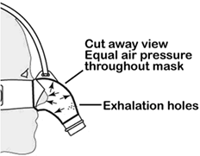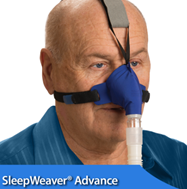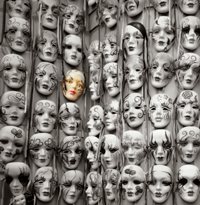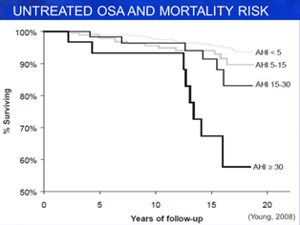Side effects of living with CPAP can include skin irritation, nose or mouth dryness, insomnia, aerophagia, claustrophobia, and altered facial anatomy growth in children. Most of these are common problems that can be prevented by making the right choice of mask and keeping up with your follow up visits both to your provider and for follow up titration studies.
 The vast majority of PAP masks are constructed of hard plastic and rubbery silicone, which can set a patient up for discomfort from moisture buildup between the interface and the skin, weight and pressure from the mask, and lack of flexibility needed to accommodate a variety of facial shapes. The Circadiance SleepWeaver line breaks from the “mold” of interfaces because they are constructed of a skin friendly soft-cloth material similar to the performance fabric found in ski clothing. SleepWeaver masks use the properties of a balloon. When a balloon is inflated, all points inside the balloon are at the same pressure. The SleepWeaver takes advantage of this property. The pressure inside of the mask is the same at all points. So the pressure being applied to the patient for their CPAP therapy is the same pressure that pushes the mask against the patient's skin. Thus, there are no localized pressure points that can create pressure sores.
The vast majority of PAP masks are constructed of hard plastic and rubbery silicone, which can set a patient up for discomfort from moisture buildup between the interface and the skin, weight and pressure from the mask, and lack of flexibility needed to accommodate a variety of facial shapes. The Circadiance SleepWeaver line breaks from the “mold” of interfaces because they are constructed of a skin friendly soft-cloth material similar to the performance fabric found in ski clothing. SleepWeaver masks use the properties of a balloon. When a balloon is inflated, all points inside the balloon are at the same pressure. The SleepWeaver takes advantage of this property. The pressure inside of the mask is the same at all points. So the pressure being applied to the patient for their CPAP therapy is the same pressure that pushes the mask against the patient's skin. Thus, there are no localized pressure points that can create pressure sores.
 In addition, because the mask material is moisture-permeable while not allowing air to pass through means it allows the skin to evaporate instead of trap moisture, all while retaining the all-important air seal to prevent leakage of CPAP pressure.
In addition, because the mask material is moisture-permeable while not allowing air to pass through means it allows the skin to evaporate instead of trap moisture, all while retaining the all-important air seal to prevent leakage of CPAP pressure.
SleepWeaver mask cloth materials, aside from being skin-friendly, are inherently flexible. This means that each style of SleepWeaver can accommodate a wide variety of facial shapes. This contributes to ease of mask matching for patients who are increasingly being fitted remotely. Therefore, SleepWeaver masks check off all the boxes to set you up for CPAP success.
Aside from comfort issues, there is still the issue of dryness that plagues many CPAP users. Mouth dryness occurs when the mouth drops open during nasal or pillows CPAP use and can be alleviated by use of a chin strap to keep the mouth closed, or use of full face mask. An over-the-counter saline spray can help with nasal dryness.
A 2004 study by Lewis⁶ found that 11% to 28% of pap patients experience claustrophobia. In a similar vein, a 2008 study by Krakow⁷ estimated that the insomnia population has as low as 17% adherence to PAP therapy. Masks that are lightweight and are constructed in such a way that they avoid the field of view tend to be better tolerated by such patients. Again, SleepWeaver nasal masks with their cloth construction have been shown to have a lower pressure exerted on the bridge of the nose than comparable nasals.⁸ And pillows and nasal masks are preferred over full face masks because they cover less surface area, especially if there is no forehead bridge integrated into the frame.
Aerophagia is bloating, gas, or burping that can occur as a result of air that bypasses the upper airway and instead flows through the esophagus into the stomach. It can be a sign of a higher than optimal CPAP pressure or need for bilevel therapy. An effective in-lab titration should prevent this occurrence or reevaluation of your CPAP pressure by your sleep provider.⁵
Children, who are still physically maturing, should be monitored for the development of facial abnormalities when receiving CPAP. This is because the pressure from the mask and air can alter the growth of the facial shape, over a period of time, in areas where the mask touches the face. It is believed that nasal pillows and lighter weight nasal masks like Circadiance SleepWeaver Advance Pediatric mitigate this risk.
 Some patients have found a “multiple mask” treatment approach works best for them in one or more of the following scenarios:⁹
Some patients have found a “multiple mask” treatment approach works best for them in one or more of the following scenarios:⁹
- Facial pain may be a reason for a patient to use multiple masks. Switching up masks that put pressure in different locations on the face may alleviate this effect. Using a lightweight mask with a lower pressure profile like SleepWeaver or a mask with a smaller footprint on the face, such as a pillows interface, may help as well.
- Patients using a nasal or pillows mask who suffer from seasonal allergies that block airflow through the nose may need to switch to a full face mask for part of each year.
- Having a second mask as a backup when one mask is drying or broken is an option as well.
- Travel could be a factor to put multiple masks into rotation (a lighter mask may be more convenient when traveling) or a patient that lives in multiple homes (patients with different homes may have multiple pap devices, each with its own mask, at each residence).
Most masks are compatible with all machines, so if this is the route that a patient takes it is reasonable to draw from multiple masks across manufacturers. However, patients will need to check that mask type is programmed into the pap machine settings to accommodate if a change is made from say nasal to full face.
 Salutary effects of PAP therapy. Untreated Sleep Apnea is associated with increased rates of obesity, type II diabetes, high blood pressure, heart disease, stroke and practical consequences in daily life such as traffic accidents, safety incidents in the workplace, falls, lost productivity at work, mood swings, waking up feeling groggy and falling asleep in class. One study, shown in this mortality risk graph,¹⁰ calculated how severely shortened the lifespan may be for someone with sleep apnea, especially as severity increases (Note: “severe” sleep apnea is indicated by an apnea-hypopnea index AHI of 30 breathing pauses/events per hour or greater). One way to think of sleep apnea is that it has a cumulative effect on the cardiovascular system similar to having a heart attack, but over the lifetime instead of as an acute event. This effect results from the burden that breathing pauses have on the level of oxygen (i.e., reduced) and carbon dioxide (i.e., increased) in the blood, which force the heart and lungs to work harder to keep oxygenated blood going to vital organs. The effect is not immediate, but when someone is having hundreds of breathing events per night, sleeping one-third of their life, that is a significant stressor! PAP therapy relieves that pressure on the cardiovascular system through its effect on the airway, and can begin to immediately reverse some of the effects of sleep apnea after the first night of use. Knowing this, it's no wonder that sleep technologists find such value in their work!
Salutary effects of PAP therapy. Untreated Sleep Apnea is associated with increased rates of obesity, type II diabetes, high blood pressure, heart disease, stroke and practical consequences in daily life such as traffic accidents, safety incidents in the workplace, falls, lost productivity at work, mood swings, waking up feeling groggy and falling asleep in class. One study, shown in this mortality risk graph,¹⁰ calculated how severely shortened the lifespan may be for someone with sleep apnea, especially as severity increases (Note: “severe” sleep apnea is indicated by an apnea-hypopnea index AHI of 30 breathing pauses/events per hour or greater). One way to think of sleep apnea is that it has a cumulative effect on the cardiovascular system similar to having a heart attack, but over the lifetime instead of as an acute event. This effect results from the burden that breathing pauses have on the level of oxygen (i.e., reduced) and carbon dioxide (i.e., increased) in the blood, which force the heart and lungs to work harder to keep oxygenated blood going to vital organs. The effect is not immediate, but when someone is having hundreds of breathing events per night, sleeping one-third of their life, that is a significant stressor! PAP therapy relieves that pressure on the cardiovascular system through its effect on the airway, and can begin to immediately reverse some of the effects of sleep apnea after the first night of use. Knowing this, it's no wonder that sleep technologists find such value in their work!
—Matthew Anastasi, BS RST RPSGT, Clinical Coordinator Consultant, Circadiance
REFERENCES
¹ Watson NF. Health Care Savings: The Economic Value of Diagnostic and Therapeutic Care for Obstructive Sleep Apnea. J Clin Sleep Med. 2016;12(8):1075-1077. Published 2016 Aug 15
² ‘CPAP Machine Changed My Life'. MedicineNet. https://www.medicinenet.com/script/main/art.asp?articlekey=158679. Published May 29, 2012.
³ Epstein LJ; Kristo D; Strollo PJ; Friedman N; Malhotra A; Patil SP; Ramar K; Rogers R; Schwab RJ; Weaver EM; Weinstein MD. Clinical guideline for the evaluation, management and long-term care of obstructive sleep apnea in adults. J Clin Sleep Med 2009;5(3):263–276
⁴ Anastasi MW. Chapter 46: Positive Airway Pressure Therapy: Basic Principles. In Lee-Chiong TD, Mattice C, Brooks R, eds., Fundamentals of Sleep Technology. 3rd ed. Wolters Kluwer Health, Inc., 2019:580-587.
⁵ Brandon Peters MD. What Side Effects to Expect From CPAP Therapy. Verywell Health. https://www.verywellhealth.com/cpap-therapy-what-are-the-side-effects-3015024.
⁶ Lewis KE et al. (2004). Early predictors of CPAP use for the treatment of sleep apnea. Sleep, 27, 134-138.
⁷ Krakow, B, et al. (2008). A daytime, abbreviated cardio-respiratory sleep study to acclimate insomnia patients with sleep disordered breathing to positive airway pressure (PAP-NAP). J Clin Sleep Med, 4,212-22.
⁸ Anastasi M, Pasquale M, Tubbs A. Comparison of PAP Interface Pressure on the Nasal Bridge: Soft Cloth vs. Traditional Masks. Abstract submitted for publication. 2020.
⁹ Perez C. Managing Multiple Masks. Sleep Review. https://www.sleepreviewmag.com/uncategorized/managing-multiple-masks/. Published August 19, 2015.
¹⁰ Young, T., Finn, L., Peppard, P. E., Szklo-Coxe, M., Austin, D., Nieto, F. J., et al. (2008). Sleep disordered breathing and mortality: eighteen-year follow-up of the Wisconsin sleep cohort. Sleep, 31(8), 1071-1078.
¹¹ Miller MA, Cappuccio FP. A systematic review of COVID-19 and obstructive sleep apnoea. Sleep Medicine Reviews. https://www.sciencedirect.com/science/article/pii/S1087079220301258?via=ihub. Published September 8, 2020.
¹² Michaud L. 4 realities of life with sleep apnea and living with your CPAP Machine. https://www.alaskasleep.com/blog/4-realities-of-life-with-sleep-apnea-living-with-your-cpap-machine.
¹³ Rodriguez J. Best Online CPAP Support Groups and Resources. Advanced Sleep Medicine Services, Inc. https://www.sleepdr.com/the-sleep-blog/best-online-cpap-support-groups-and-resources/. Published December 7, 2016.





